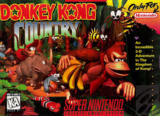A faithful port of one of the SNES's classics delivers solid 2D platforming action that almost anyone can enjoy.
2D platformers were still king back in the early-90's, and the gold standard to emulate was the Mario series. After years of being the antagonist in a range of games, Donkey Kong finally becomes a protagonist for once. Instead of rescuing a kidnapped princess from a sinister reptile, Donkey Kong gets to rescue his kidnapped banana hoard from a sinister reptile. What are this reptile's dastardly intentions with said bananas? Apparently Nintendo is hoping that you do not ask that, as the only possible scenario would be using the bananas as a fuel source for dirty nuclear bombs. Not only would the images of such an attack scar children for life, it would also create a serious slipping hazard in the banana peel fallout. Other than that, there are many basic similarities with the Mario franchise. Instead of 100 coins for an extra life, you collect 100 bananas. Instead of collecting a mushroom for an extra life, you collect a balloon. Pits remain bottomless (yet you somehow appear at the top seconds later), spikes remain rather unhealthy, and merely touching a goofy gopher remains highly lethal.
However, this also isn't your standard Mario. Instead of various power-ups, you can control two characters - Donkey Kong and his sidekick Diddy Kong. In actuality you control one, while the other automatically trails behind you, and you can switch between the two at any time. While there are minor differences between the two apes, there are rarely any situations where you are required to use one or the other. Getting hit by an enemy will cause you to lose the active character and immediately switch to the backup character. Throughout the stages there are special barrels that will allow you to regain your partner. Barrels themselves also play a big offensive role, allowing you to shatter, trample, or explode your enemies depending on the type of barrel. The Kongs can also roll their way through much of their opposition. While Mario had Yoshi to ride around, the Kongs get a wider selection of mounts - a rhino, a frog, an ostrich, and a spearfish. Each brings various strengths and weaknesses to the table, though they tend to be uncommon and placed right before you would benefit from one of their strengths.
Despite its many similarities to a standard platformer and not having any truly memorable stages or elements, Donkey Kong Country does hold its own pretty well. It certainly has its own unique style, especially with stages that focus on small platforms or cannon-like barrels that fire you across wide gaps. It may not be the most refined platformer compared to its contemporaries, but it certainly is solid. Even a decade later, the gameplay remains as entertaining as it was when it first came out. There were some minor issues in the translation to the GBA, the most notable of which the run and roll buttons were combined due to the GBA having only two face buttons instead of four. There are instances on tiny platforms when you may want to hold down the run button, but you'd inadvertently roll right off the ledge.
While the game still retains its graphical charm, it is not nearly as eye-popping at it was on the SNES. Many of the 2D games on the GBA use similar techniques to draw their sprites and backgrounds, so what once was new is now commonplace. Still, many of the backgrounds in particular show a great level of polish after all these years, from the famous tree-top villages to the icy hills, dense jungles, and dark caverns. After all of these years, the underwater levels still are among the best visually in 2D gaming. Even with the lower resolution of the GBA screen, the game still manages to convert in a way such that barely-visible platforms at the edge of a screen still remains barely visible instead of clipping off the screen. While not as good as the graphics, the audio matches up rather well with the setting. Congo beats are prevalent throughout the jungles, an ominous echoing tune in caverns, and a high-tempo track during boss battles.
The game itself will lead you to conquer seven boss fights and 35 sometimes short stages over six themed areas. While some of the later stages can eat away at your extra lives until you time the leaps perfectly, going through the entire game will take a handful of hours. Most of the extra content revolves around finding hidden areas that contain various bonuses, usually amounting to about two per level. While some of these are obvious, others require tricky maneuvering or even leaps of faith. The GBA version includes two new minigames and some collectable snapshots for a photo album, and an unlockable hard mode. However, these additions are all fairly minor and are only occasional diversions.
In the end, Donkey Kong Country is a faithful port of one of the SNES's bestsellers. Anyone who enjoys 2D platformers and missed this game the first time around should certainly go and pick up a copy for the GBA. Those that played the original extensively will find little of substance to pick up this game, unless they simply want a portable version of one of their favorite games. For those who are interested in reliving one of the classics of the SNES generation, then Donkey Kong Country certainly delivers.

